It looks like you're using an Ad Blocker.
Please white-list or disable AboveTopSecret.com in your ad-blocking tool.
Thank you.
Some features of ATS will be disabled while you continue to use an ad-blocker.
share:
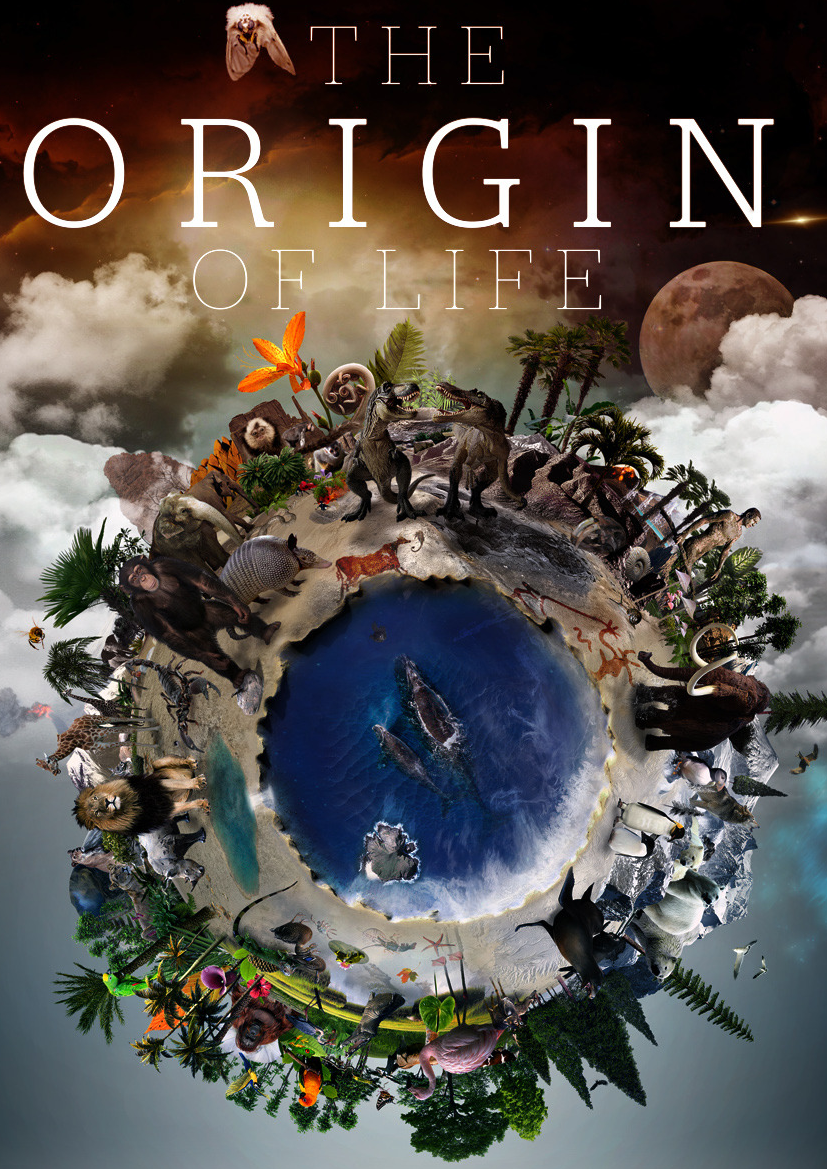
Metabolic processes that underpin life on Earth have arisen spontaneously outside of cells. The serendipitous finding that metabolism – the cascade of reactions in all cells that provides them with the raw materials they need to survive – can happen in such simple conditions provides fresh insights into how the first life formed. It also suggests that the complex processes needed for life may have surprisingly humble origins.
Hello everybody. This is my first thread. I hope it will entertaining and strike up some good debate. I am no expert but would love to read some other user's comments.

Spark of life: Metabolism appears in lab without cells
"People have said that these pathways look so complex they couldn't form by environmental chemistry alone," says Markus Ralser at the University of Cambridge who supervised the research.
But his findings suggest that many of these reactions could have occurred spontaneously in Earth's early oceans, catalysed by metal ions rather than the enzymes that drive them in cells today.
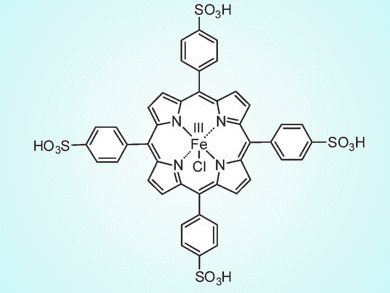
These metal ions are extremely important. They are basically the framework for these chemical reactions to take place.
"This is the first experiment showing that it is possible to create metabolic networks in the absence of RNA," Ralser says.
RNA
One theory is that RNA was the first building block of life because it helps to produce the enzymes that could catalyse complex sequences of reactions. Another possibility is that metabolism came first; perhaps even generating the molecules needed to make RNA, and that cells later incorporated these processes – but there was little evidence to support this.
This begs the question: Which came first, my metabolism or my RNA? Don't ask that at parties, especially if you are looking to score.
The experiment
Remarkably, the discovery was an accident, stumbled on during routine quality control testing of the medium used to culture cells at Ralser's laboratory. As a shortcut, one of his students decided to run unused media through a mass spectrometer, which spotted a signal for pyruvate – an end product of a metabolic pathway called glycolysis.
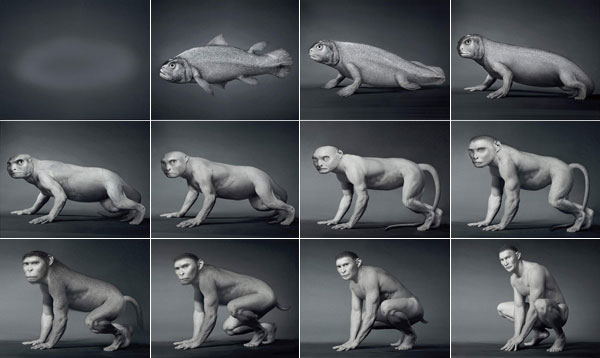
To test whether the same processes could have helped spark life on Earth, they approached colleagues in the Earth sciences department who had been working on reconstructing the chemistry of the Archean Ocean, which covered the planet almost 4 billion years ago. This was an oxygen-free world, predating photosynthesis, when the waters were rich in iron, as well as other metals and phosphate. All these substances could potentially facilitate chemical reactions like the ones seen in modern cells.
Metabolic backbone
Ralser's team took early ocean solutions and added substances known to be starting points for modern metabolic pathways, before heating the samples to between 50˚C and 70˚C – the sort of temperatures you might have found near a hydrothermal ventMovie Camera – for 5 hours. Ralser then analysed the solutions to see what molecules were present.
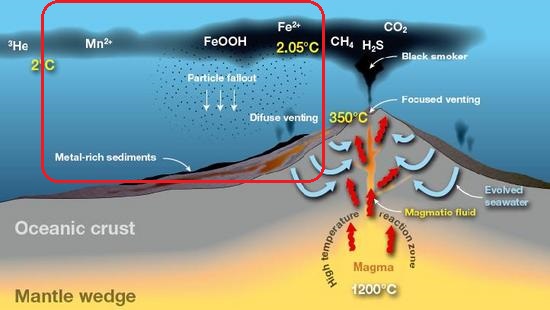
"In the beginning we had hoped to find one reaction or two maybe, but the results were amazing," says Ralser. "We could reconstruct two metabolic pathways almost entirely."
The pathways they detected were glycolysis and the pentose phosphate pathway, "reactions that form the core metabolic backbone of every living cell," Ralser adds. Together these pathways produce some of the most important materials in modern cells, including ATP – the molecule cells use to drive their machinery, the sugars that form DNA and RNA, and the molecules needed to make fats and proteins.
If these metabolic pathways were occurring in the early oceans, then the first cells could have enveloped them as they developed membranes.
In all, 29 metabolism-like chemical reactions were spotted, seemingly catalysed by iron and other metals that would have been found in early ocean sediments. The metabolic pathways aren't identical to modern ones; some of the chemicals made by intermediate steps weren't detected. However, "if you compare them side by side it is the same structure and many of the same molecules are formed," Ralser says. These pathways could have been refined and improved once enzymes evolved within cells.
Iron is at the center of these molecules. The are the driving force between electron exchanges and could have made way for the first cellular organism.
Reversible reaction
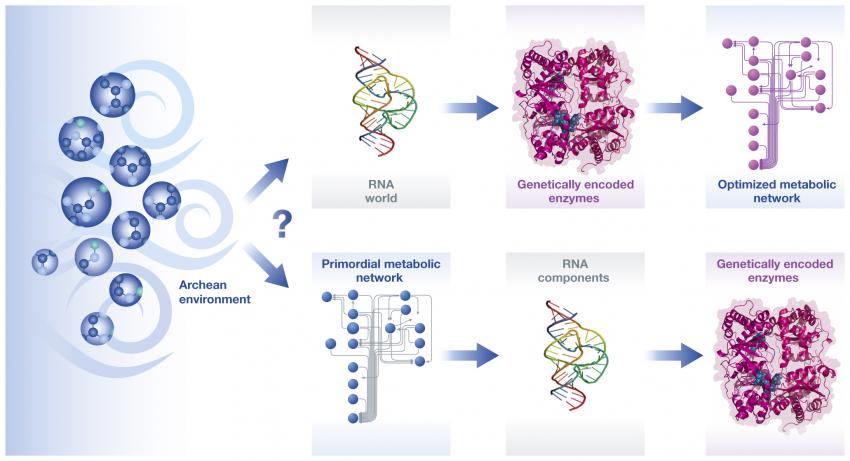
Detecting the metabolite ribose 5-phosphate is particularly noteworthy, Ralser says. This is because it is a precursor to RNA, which encodes information, catalyses chemical reactions and most importantly of all, can replicate.
"I think this paper has really interesting connotations for the origins of life," says Matthew Powner at University College London. It hints at how more complex enzymes could have evolved, he says, because substances that made these early processes more efficient would have been selected for.
A related issue is that the reactions observed so far only go in one direction; from complex sugars to simpler molecules like pyruvate. "Given the data, one might well conclude that any organics in the ocean would have been totally degraded, rather than forming the basis of modern metabolism," says Jack Szostak, who studies the origin of life at Harvard. "I would conclude that metabolism had to evolve, within cells, one reaction and one catalyst at a time."
But Ralser disagrees. In his opinion, whether the reaction is catalysed by an enzyme or by a molecule in the Archean Ocean leads to the same result; "every chemical reaction is in principle reversible, whether an enzyme or a simple molecule is the catalyst," he says.
What do you think?
If we can some how link the creation of multi-cellular organisms to this phenomenon, is this technically considered evolution in the making?
edit on 26-4-2014 by eisegesis because: (no reason given)
Thanks for the thread, and the images etc, I think adding to the article with such adds to the thread.
However there is already a thread on this. Perhaps you could post the graphics from the article on there, as they might add to that thread.
www.abovetopsecret.com...
However there is already a thread on this. Perhaps you could post the graphics from the article on there, as they might add to that thread.
www.abovetopsecret.com...
edit on 26-4-2014 by theabsolutetruth because: (no reason given)
a reply to: eisegesis
I have been reading a lot of this stuff recently. It is quite clear that the research is uncovering multiple methods of achieving the basics necessary for life. Which to me suggests that life is probably far far more prevelent in the universe than we think and it is most likely different. The astronomers are also throwing in discoveries that vastly increases the quantity of planets that could harbour life rather than the one variety we know does have life.
I have been reading a lot of this stuff recently. It is quite clear that the research is uncovering multiple methods of achieving the basics necessary for life. Which to me suggests that life is probably far far more prevelent in the universe than we think and it is most likely different. The astronomers are also throwing in discoveries that vastly increases the quantity of planets that could harbour life rather than the one variety we know does have life.
originally posted by: eisegesis
a reply to: DarknStormy
Try not to let it bother you, it's just for fun. Of course it's ridiculous.
When you can understand that just about every example of Evolution concerning Humans and Apes has been proven to be manipulated and a hoax, then we can move on from this ridiculous subject and leave it in the past somewhere.
a reply to: DarknStormy
Yes, that graphic leaves much to be desired.
But, do you have an alternate theory to counter evolution? Or just snide remarks and vague assertions of mass ignorance?
Why do I bother?
Yes, that graphic leaves much to be desired.
But, do you have an alternate theory to counter evolution? Or just snide remarks and vague assertions of mass ignorance?
Why do I bother?
edit on 26-4-2014 by watchitburn because: (no reason given)
a reply to: DarknStormy
That really isn't the point of the thread though. I believe you're taking the picture too serious. The thread is about a possible precursor to our own RNA. It is explaining that areas on earth that couldn't support biological life, can create similar cellular functions as those that do.
That really isn't the point of the thread though. I believe you're taking the picture too serious. The thread is about a possible precursor to our own RNA. It is explaining that areas on earth that couldn't support biological life, can create similar cellular functions as those that do.
a reply to: eisegesis
Wow! Amazing! S&F!
If these metabolic pathways exist naturally in the environment ... then for me it raises questions about the Gaia hypothesis ...
... Because it implies that inorganic environments already contain metabolic pathways and hence the entire planet is alive as an ecosystem at all times!
Also this has consequences for the Drake equation ...
... and we can now refine that equation further!
Finally ...
Yes, I think we can credibly infer that this is technically considered evolution in the making!
Wow! Amazing! S&F!
If these metabolic pathways exist naturally in the environment ... then for me it raises questions about the Gaia hypothesis ...
The Gaia hypothesis, also known as Gaia theory or Gaia principle, proposes that organisms interact with their inorganic surroundings on Earth to form a self-regulating, complex system that contributes to maintaining the conditions for life on the planet.
... Because it implies that inorganic environments already contain metabolic pathways and hence the entire planet is alive as an ecosystem at all times!
Also this has consequences for the Drake equation ...
The Drake equation is a probabilistic argument used to estimate the number of active, communicative extraterrestrial civilizations in the Milky Way galaxy. The equation was written in 1961 by Frank Drake not for purposes of quantifying the number of civilizations, but intended as a way to stimulate scientific dialogue at the world's first SETI meeting, in Green Bank, West Virginia. The equation summarizes the main concepts which scientists must contemplate when considering the question of other radio-communicative life. The Drake equation has proved controversial since several of its factors are currently unknown, and estimates of their values span a very wide range. This has led critics to label the equation a guesstimate, or even meaningless.
... and we can now refine that equation further!
Finally ...
If we can some how link the creation of multi-cellular organisms to this phenomenon, is this technically considered evolution in the making?
Yes, I think we can credibly infer that this is technically considered evolution in the making!
originally posted by: DarknStormy
originally posted by: eisegesis
a reply to: DarknStormy
Try not to let it bother you, it's just for fun. Of course it's ridiculous.
When you can understand that just about every example of Evolution concerning Humans and Apes has been proven to be manipulated and a hoax, then we can move on from this ridiculous subject and leave it in the past somewhere.
Well . . . then, it should be fairly easy to produce that evidence. You know, that all evidence has been "proven" to be a hoax.
I'll wait . . . and FYI, YouTube vids and assertion are not considered "proof".

Evolution of Metabolic Pathways
There is more to the complexity of metabolism than understanding the metabolic pathways alone. Metabolic complexity varies from organism to organism. Photosynthesis is the primary pathway in which photosynthetic organisms like plants (the majority of global synthesis is done by planktonic algae) harvest the sun’s energy and convert it into carbohydrates. The by-product of photosynthesis is oxygen, required by some cells to carry out cellular respiration. During cellular respiration, oxygen aids in the catabolic breakdown of carbon compounds, like carbohydrates. Among the products of this catabolism are CO2 and ATP. In addition, some eukaryotes perform catabolic processes without oxygen (fermentation); that is, they perform or use anaerobic metabolism.
Organisms probably evolved anaerobic metabolism to survive (living organisms came into existence about 3.8 billion years ago, when the atmosphere lacked oxygen). Despite the differences between organisms and the complexity of metabolism, researchers have found that all branches of life share some of the same metabolic pathways, suggesting that all organisms evolved from the same ancient common ancestor. Evidence indicates that over time, the pathways diverged, adding specialized enzymes to allow organisms to better adapt to their environment, thus increasing their chance to survive. However, the underlying principle remains that all organisms must harvest energy from their environment and convert it to ATP to carry out cellular functions.
Comparative genomics and evolution of proteins involved in RNA metabolism
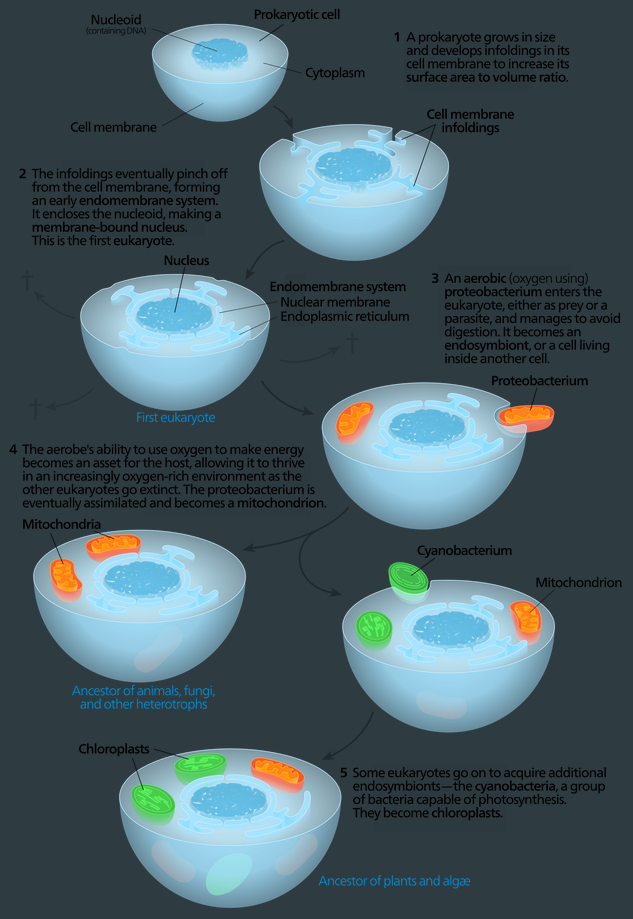
The most notable phase of innovation in RNA metabolism coincides with the advent of eukaryotes and was brought about by the merge of the archaeal and bacterial systems via mitochondrial endosymbiosis, but also involved emergence of several new, eukaryote-specific RNA-binding domains.
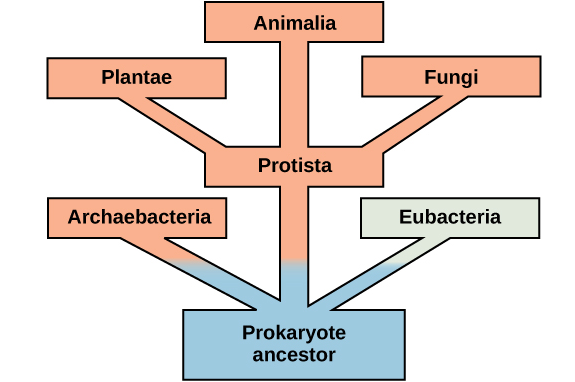
Another lame picture.
The endosymbiotic theory states that several key organelles of eukaryotes originated as symbioses between separate single-celled organisms. According to this theory, mitochondria and plastids (e.g. chloroplasts), and possibly other organelles, represent formerly free-living bacteria that were taken inside another cell as an endosymbiont. Molecular and biochemical evidence suggest that the mitochondrion developed from proteobacteria (in particular, Rickettsiales, the SAR11 clade, or close relatives) and the chloroplast from cyanobacteria.
edit on 26-4-2014 by eisegesis because: (no reason given)
originally posted by: watchitburn
a reply to: DarknStormy
Yes, that graphic leaves much to be desired.
But, do you have an alternate theory to counter evolution? Or just snide remarks and vague assertions of mass ignorance?
Why do I bother?
Counter evolution? Evolution cannot be proven to begin with. The missing links in Darwins theory still to this day have never been found and some believe that they will never be found because the theory itself is a load of bs. There is no evidence to suggest humans evolved from primates because the very foundations of that idea have been proven to be manipulated hoaxes as the video shows.
Believing in evolution is like believing in religion. The truth is you are never going to find the origin of species whether through fossil records or even God. You either believe it or you don't, you either put your faith into it or you don't. I choose not to because the theory has many cracks which cannot be repaired and by the sounds of it will never be repaired.
edit on 26-4-2014 by DarknStormy because: (no reason given)
a reply to: solomons path
So a couple of guys show you in the video why the skulls and bones are not proof and it doesn't add up to enough evidence? It's proving that the entire concept has been a hoax orchestrated by morons who cannot admit they are wrong. Putting a monkeys jaw bone on a human skull and then calling it Ape man is not evolution, it's called a hoax.
So a couple of guys show you in the video why the skulls and bones are not proof and it doesn't add up to enough evidence? It's proving that the entire concept has been a hoax orchestrated by morons who cannot admit they are wrong. Putting a monkeys jaw bone on a human skull and then calling it Ape man is not evolution, it's called a hoax.
Thanks OP, great read and time killer!
So many unknown variables, but we are edging closer to finding out our origins.
SnF great thread and presentation!
So many unknown variables, but we are edging closer to finding out our origins.
SnF great thread and presentation!
originally posted by: DarknStormy
originally posted by: watchitburn
a reply to: DarknStormy
Yes, that graphic leaves much to be desired.
But, do you have an alternate theory to counter evolution? Or just snide remarks and vague assertions of mass ignorance?
Why do I bother?
Counter evolution? Evolution cannot be proven to begin with. The missing links in Darwins theory still to this day have never been found and some believe that they will never be found because the theory itself is a load of bs. There is no evidence to suggest humans evolved from primates because the very foundations of that idea have been proven to be manipulated hoaxes as the video shows.
Believing in evolution is like believing in religion. The truth is you are never going to find the origin of species whether through fossil records or even God. You either believe it or you don't, you either put your faith into it or you don't. I choose not to because the theory has many cracks which cannot be repaired and by the sounds of it will never be repaired.
The fact that you promote the fallacy of "missing links" shows how little you know about evolutionary theory claims or the evidence for it.
The missing link argument was not something that scientists brought up, it's an ecclesiastical criticism based on an anthropocentric view of life. Evolution is not a straight line, and even if it was, you seem to be woefully ignorant as to the conditions needed to preserve said "link". You also seem to be ignorant about all of the other substanciating evidence from disparate fields, like geology, genetics, microbio, biochem, paleontology, anthro and paleoanthropology, biogeography, comparative anatomy/physiology/morphology, etc . ..
All fields converge and point to one unmistakable conclusion. There is no "controversy" or "holes" are concerned unless you approach it from a anthropocentric view that religion (creation and ID) promotes. No one piece of evidence is the "proof" of evolution, so even show how one minute fact may be in error won't "damage" the modern synthesis theory of evolution.
For example, how can biologists counter the creationist argument that there are still many missing links in the fossil record that make evolutionary theory unworkable? Conway Morris noted that an understanding of what those missing links are is a good start. He pointed out that a marked phenotypic change, facilitating rapid evolution, might arise from a single-nucleotide polymorphism. “Life often seems as if it walks on a knife edge,” he said. “But in cases such as this there won't be an intermediate in the fossil record.” In any case, the fossil record contains numerous transitional forms that allow the reconstruction of, for example, the development of the modern whale (Balaena spp.) from the hippo-like Diacodexis spp., which existed some 50 million years ago. Missing links emerge regularly and it is quite likely that palaeontologists have simply not discovered them all yet.
Taking on creationism
The phrase missing link has been used extensively in popular writings on human evolution to refer to a perceived gap in the hominid evolutionary record. It is most commonly used to refer to any new transitional fossil finds. Scientists, however, do not use the term, as it refers to a pre-evolutionary view of nature.
Maybe you should brush up on what arguements are still current among creationists . . .
Creation.com "Arguments we think creationists shouldn't use."
originally posted by: DarknStormy
a reply to: solomons path
So a couple of guys show you in the video why the skulls and bones are not proof and it doesn't add up to enough evidence? It's proving that the entire concept has been a hoax orchestrated by morons who cannot admit they are wrong. Putting a monkeys jaw bone on a human skull and then calling it Ape man is not evolution, it's called a hoax.
The hoax have been exposed as hoax . . . almost 100yrs ago, yet you still think scientists that actually work in anthro or bio still promote it? BTW - there was only one "hoax" and that was Piltdown Man.
To be honest I stopped watching a minute in . . . very dated material for one, but right off the bat the man makes a claim that hasn't been true since the turn of the 20th century about likelyhood of finding transitional forms is extremely low. That is false.
Roger Cuffey's 1974 paper on paleontologic evidence listed references for at least 139 fine-grained species to species transitional sequences. According to an expectation derived from Darwin's own words and values from the real world, it can be seen that the fossils have been rather more forthcoming than one would expect, not less.
The term "missing link" refers back to the originally static pre-evolutionary concept of the great chain of being, a deist idea that all existence is linked, from the lowest dirt, through the living kingdoms to angels and finally to God. The idea of all living things being linked through some sort of transmutation process predates Darwin's theory of evolution. Jean-Baptiste Lamarck envisioned that life is generated in the form of the simplest creatures constantly, and then strive towards complexity and perfection (i.e. humans) through a series of lower forms. In his view, lower animals were simply newcomers on the evolutionary scene.
Transitional Fossil - wiki
Transitional Fossils - TO
edit on 4/26/14 by solomons path because: (no reason
given)
edit on 4/26/14 by solomons path because: (no reason given)
I think my ancestors came from the Sea. I'm a Finn and Finns are from fish..
Nice thread though, but I still think that organization of life on this planet has ties to something bigger that science does not define using evolution alone. Could be that all life in the universe is somehow linked, that would be enough to make this possible. If DNA was introduced to earth from a much older origin, it would be believable also. Maybe on asteroids.
Nice thread though, but I still think that organization of life on this planet has ties to something bigger that science does not define using evolution alone. Could be that all life in the universe is somehow linked, that would be enough to make this possible. If DNA was introduced to earth from a much older origin, it would be believable also. Maybe on asteroids.
a reply to: eisegesis
A star and a flag for you, though I wish you had used this as your thread title instead:
That is really the big news here; it carries the discussion about abiogenesis back to before the RNA World model.
You may also find this thread interesting: Abiogenesis not probable but inevitable, says physicist.
The premise fits in quite well with yours, as it happens.
A star and a flag for you, though I wish you had used this as your thread title instead:
It is possible to create metabolic networks in the absence of RNA
That is really the big news here; it carries the discussion about abiogenesis back to before the RNA World model.
You may also find this thread interesting: Abiogenesis not probable but inevitable, says physicist.
The premise fits in quite well with yours, as it happens.
edit on 27/4/14 by Astyanax because: of spacing.
a reply to: Astyanax
The question is, when do we actually start calling life...life?
Different phases of matter can be manipulated with temperature. We all boil down to the same crud. The difference is your crud and lets say, a banana's, just wont see a common ancestor until about 3.5 billion years ago.
The First Life on Earth
Everything is a sum of it's parts. We exist because are parts have found a way to work together, just like molecules coming together to form a cell. Continuing this process takes us beyond the cellular level and eventually you couldn't tell the difference between me and a Venus fly trap. We all turn into the metabolic systems that produce any life in the first place, human, monkey or banana.
From your thread:
A phenomenon of cellular adaptation. Notice how I didn't use the word "evolution".
The question is, when do we actually start calling life...life?
Different phases of matter can be manipulated with temperature. We all boil down to the same crud. The difference is your crud and lets say, a banana's, just wont see a common ancestor until about 3.5 billion years ago.
The First Life on Earth
Earth was able to support life only after the planet had cooled enough for a rocky crust to solidify. Once that happened, water vapor from volcanoes condensed in the atmosphere, fell as rain, and collected on the Earth’s surface. Besides water vapor, volcanoes also produced gases rich in the basic ingredients of life: carbon, hydrogen, oxygen, and nitrogen. Toxic gases such as ammonia and methane were common. At this point, Earth's early atmosphere consisted entirely of these volcanic gases, and there was no free oxygen. In the primordial “soup” of the early seas, organic molecules concentrated, formed more complex molecules, and became simple cells.
The transition from complex organic molecules to living cells could have occurred in several environments. Small, warm ponds are one possibility, but recent work has suggested that deep-sea hydrothermal vents, such as those found along mid-ocean spreading centers today, may have been the cradle of Earth's life. These environments contain the chemicals and the source of energy needed to synthesize more complex organic structures. Although scientists have not succeeded in creating life from organic molecules in the laboratory, they have reproduced many of the intermediate steps.
So what were the first living things and when did they appear? Studies of genetic material indicate that a living group of single-celled organisms called Archaea may share many features with early life on Earth. Many Archaea now live in hot springs, deep-sea vents, saline water, and other harsh environments. If the first organisms resembled modern Archaea, they also may have lived in such places, but direct evidence for early life is controversial because it is difficult to distinguish between complex inorganic structures and simple biological ones in the geologic record. The oldest evidence for life may be 3.5-billion-year-old sedimentary structures from Australia that resemble stromatolites. Stromatolites are created today by living mats of microorganisms (mostly cyanobacteria, or blue-green algae). These primitive organisms trap thin layers of sediment with their sticky filaments and grow upward to get light for photosynthesis. Modern-day examples of stromatolites can be found in waters off Australia, the Bahamas, and Belize.
In the Archean structures, layers similar to those seen in living stromatolites are evident, and secondary structures interpreted as simple filamentous microfossils have been recovered from the layers. The biotic origin of the structures has, however, been questioned. Both the supposed Archean stromatolites and the microfossils may have been produced by inorganic processes. Regardless, uncontested microfossils and chemical traces of life were present at least by 2.7 billion years ago. Stromatolites that were produced by microorganisms are abundant later in the Archean and throughout the Proterozoic. These sedimentary structures, formed by organic processes, provide important evidence of early life. At present, we can say with certainty that life had evolved by 2.7 billion years ago, and possibly as early as 3.5 billion years ago.
Everything is a sum of it's parts. We exist because are parts have found a way to work together, just like molecules coming together to form a cell. Continuing this process takes us beyond the cellular level and eventually you couldn't tell the difference between me and a Venus fly trap. We all turn into the metabolic systems that produce any life in the first place, human, monkey or banana.
From your thread:
His theory does not supersede or discredit Darwinian evolution, but is complementary to it. 'I am certainly not saying that Darwinian ideas are wrong,' he said. 'On the contrary, I am just saying that from the perspective of the physics, you might call Darwinian evolution a special case of a more general phenomenon.'
A phenomenon of cellular adaptation. Notice how I didn't use the word "evolution".
edit on 27-4-2014 by eisegesis because: (no reason given)
new topics
-
Bizarre Labour Party Tic Toc Video Becomes Even More Embarrassing
Regional Politics: 3 hours ago -
Potter to WHU
World Sports: 8 hours ago -
Dr. Demento
Music: 10 hours ago -
The elephant in the room (wearing a hoodie)
US Political Madness: 10 hours ago
top topics
-
The elephant in the room (wearing a hoodie)
US Political Madness: 10 hours ago, 14 flags -
To become president, Zelensky had to learn Ukrainian
Political Conspiracies: 17 hours ago, 9 flags -
Dr. Demento
Music: 10 hours ago, 6 flags -
Bizarre Labour Party Tic Toc Video Becomes Even More Embarrassing
Regional Politics: 3 hours ago, 4 flags -
Potter to WHU
World Sports: 8 hours ago, 2 flags
active topics
-
The elephant in the room (wearing a hoodie)
US Political Madness • 21 • : fringeofthefringe -
Los Angeles brush fires latest: 2 blazes threaten structures, prompt evacuations
Mainstream News • 250 • : xuenchen -
Post A Funny (T&C Friendly) Pic Part IV: The LOL awakens!
General Chit Chat • 8009 • : Cymru -
Bizarre Labour Party Tic Toc Video Becomes Even More Embarrassing
Regional Politics • 8 • : gortex -
President Carter has passed
Mainstream News • 55 • : cherokeetroy -
What Comes After January 20th
Mainstream News • 39 • : DontTreadOnMe -
House Passes Laken Riley Act
Mainstream News • 23 • : WeMustCare -
-@TH3WH17ERABB17- -Q- ---TIME TO SHOW THE WORLD--- -Part- --44--
Dissecting Disinformation • 3977 • : IndieA -
To become president, Zelensky had to learn Ukrainian
Political Conspiracies • 31 • : FlyersFan -
S.C. Jack Smith's Final Report Says Trump Leads a Major Conspiratorial Criminal Organization!.
Political Conspiracies • 45 • : WeMustCare
